Submitted:
27 February 2024
Posted:
27 February 2024
You are already at the latest version
Abstract
Keywords:
1. Introduction
- • achieving quite large dimensions connected to rapid growth and increase in biomass (e.g., LAI);
- • quick impact on the local microclimate, e.g., shading, transpiration, protection against wind and noise;
- • the phytoremediation abilities like filtration of particular matter (PM) or gas pollutions from air or absorption of heavy metals from water and soil;
- • the high adaptability to various soil and water conditions;
- • considerable tolerance to pollution of air, water and soil;
- • mass production of nursery material;
- • good planting efficiency with the minimum necessary maintenance.
2. Materials and Methods
3. Results
- • obtaining quick visual results in urban green spaces and cityscape itself;
- • reinforcing environment and shaping a favorable microclimate in a relatively short time;
- • covering and masking buildings and unattractive objects and views, e.g., warehouses, landfills and heaps, etc.
3.1. The Contribution of Poplars to Urban Environment
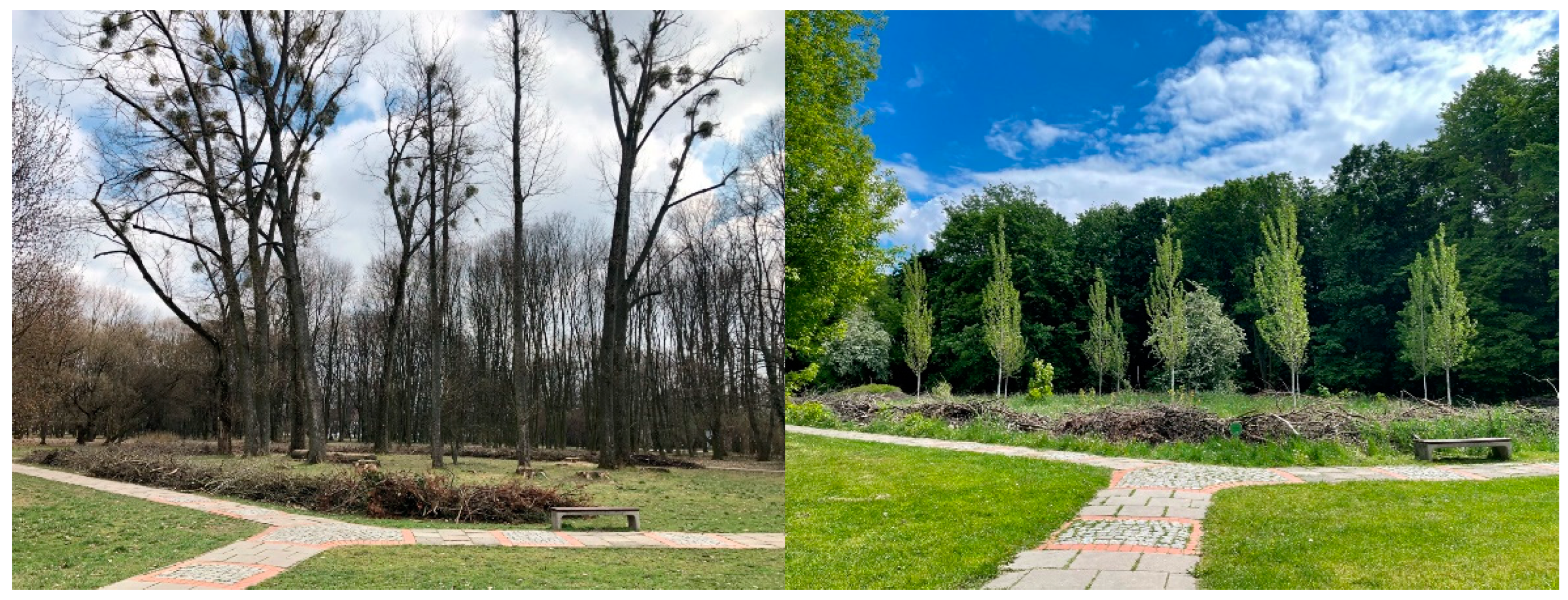
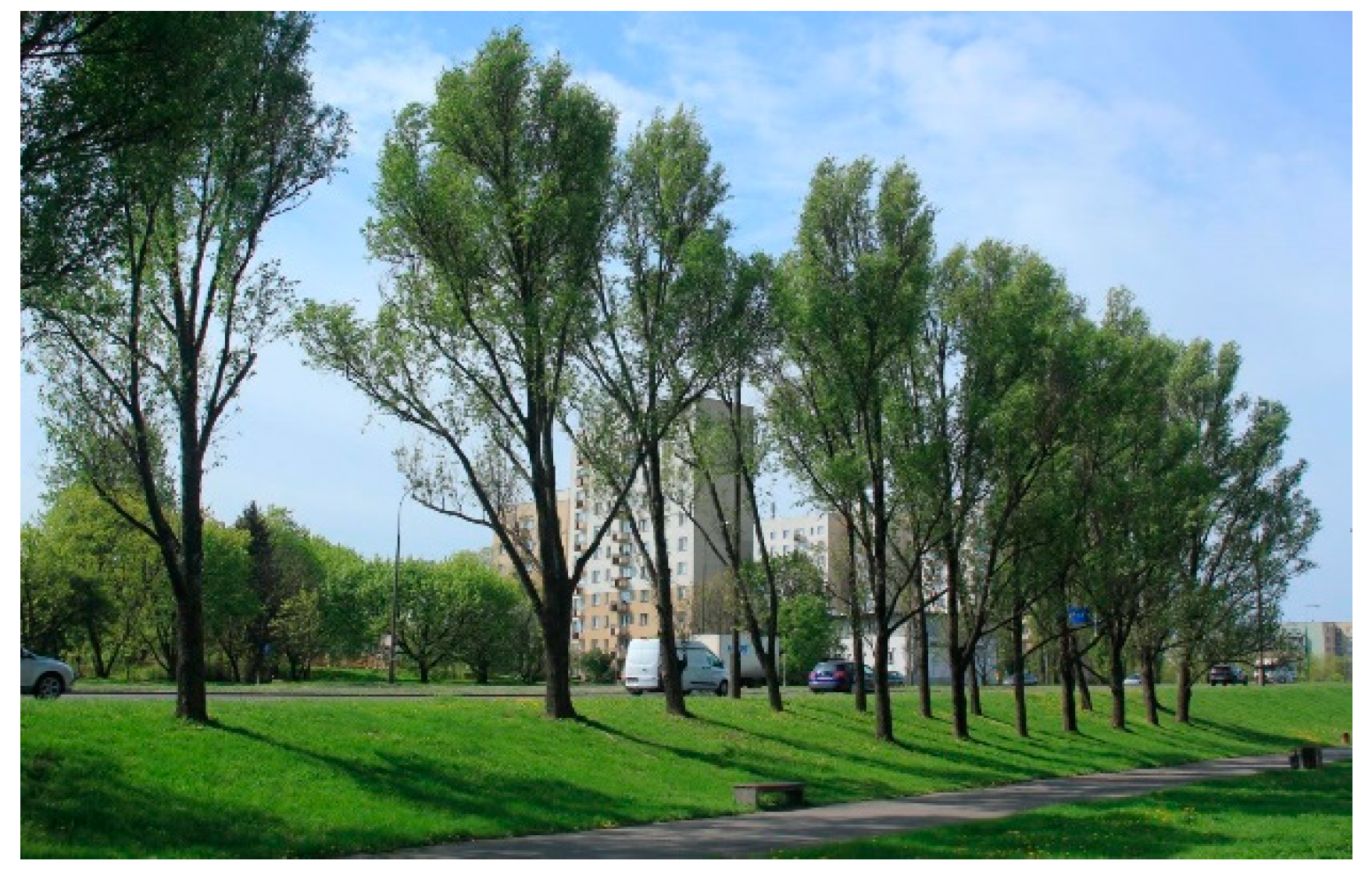
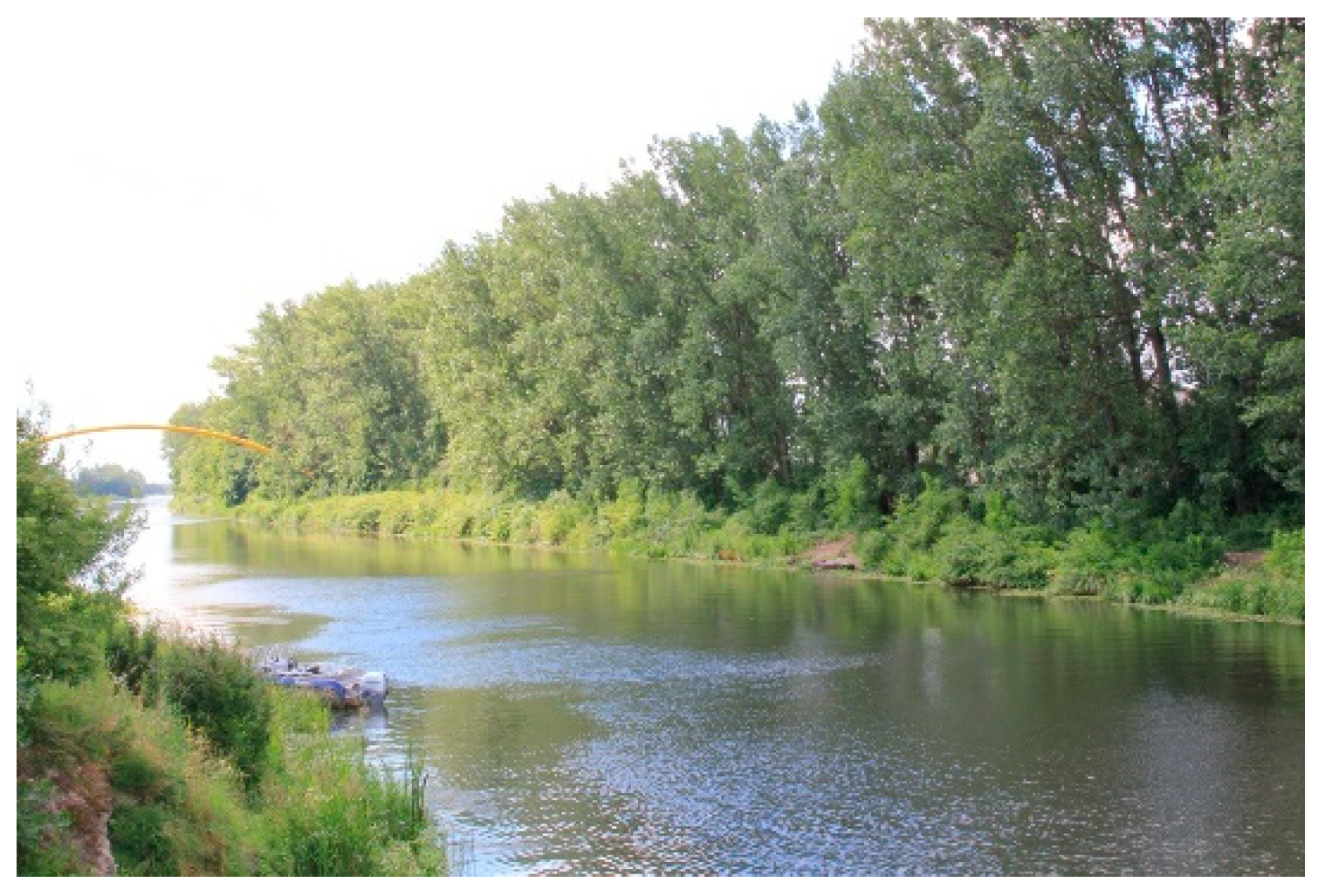
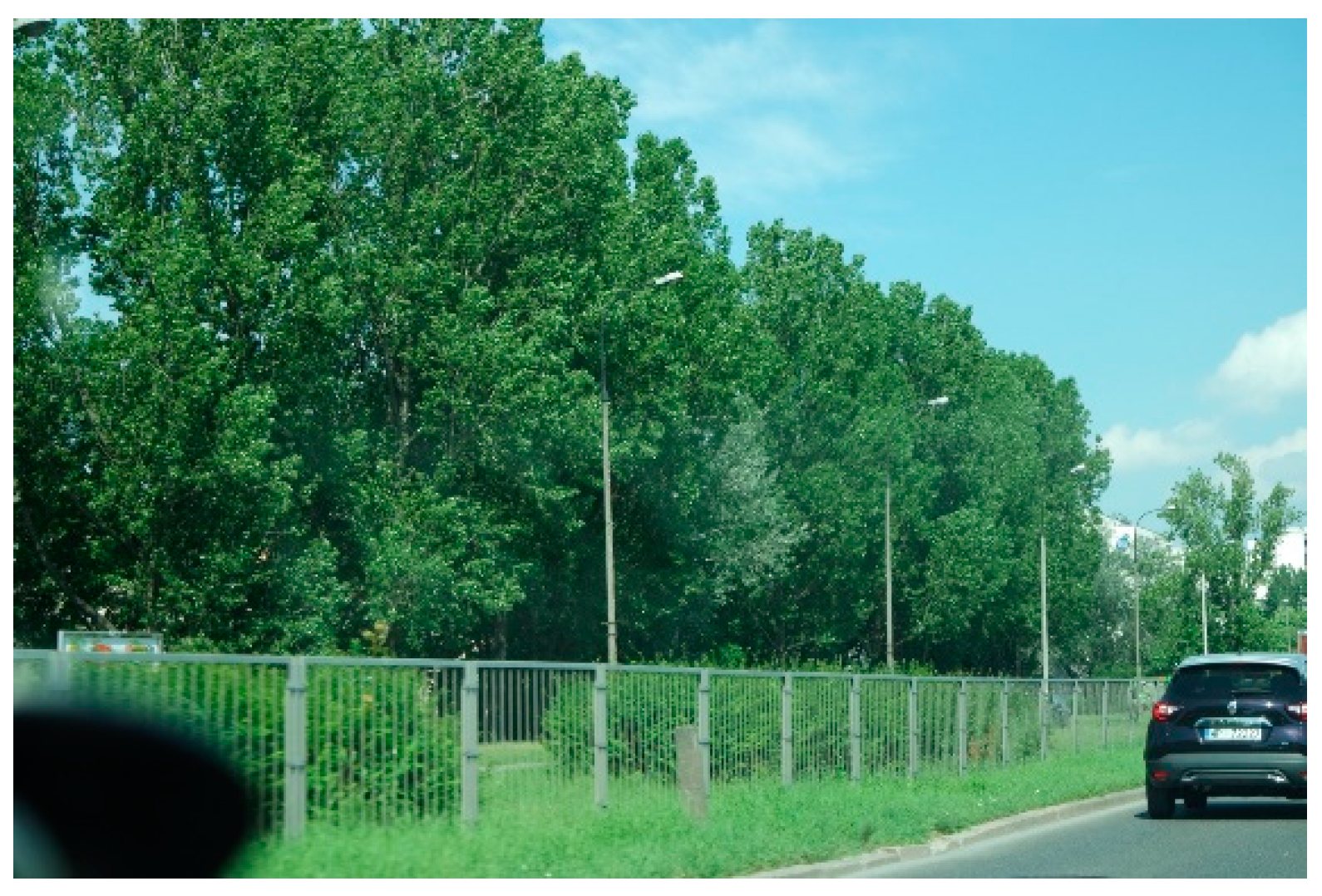
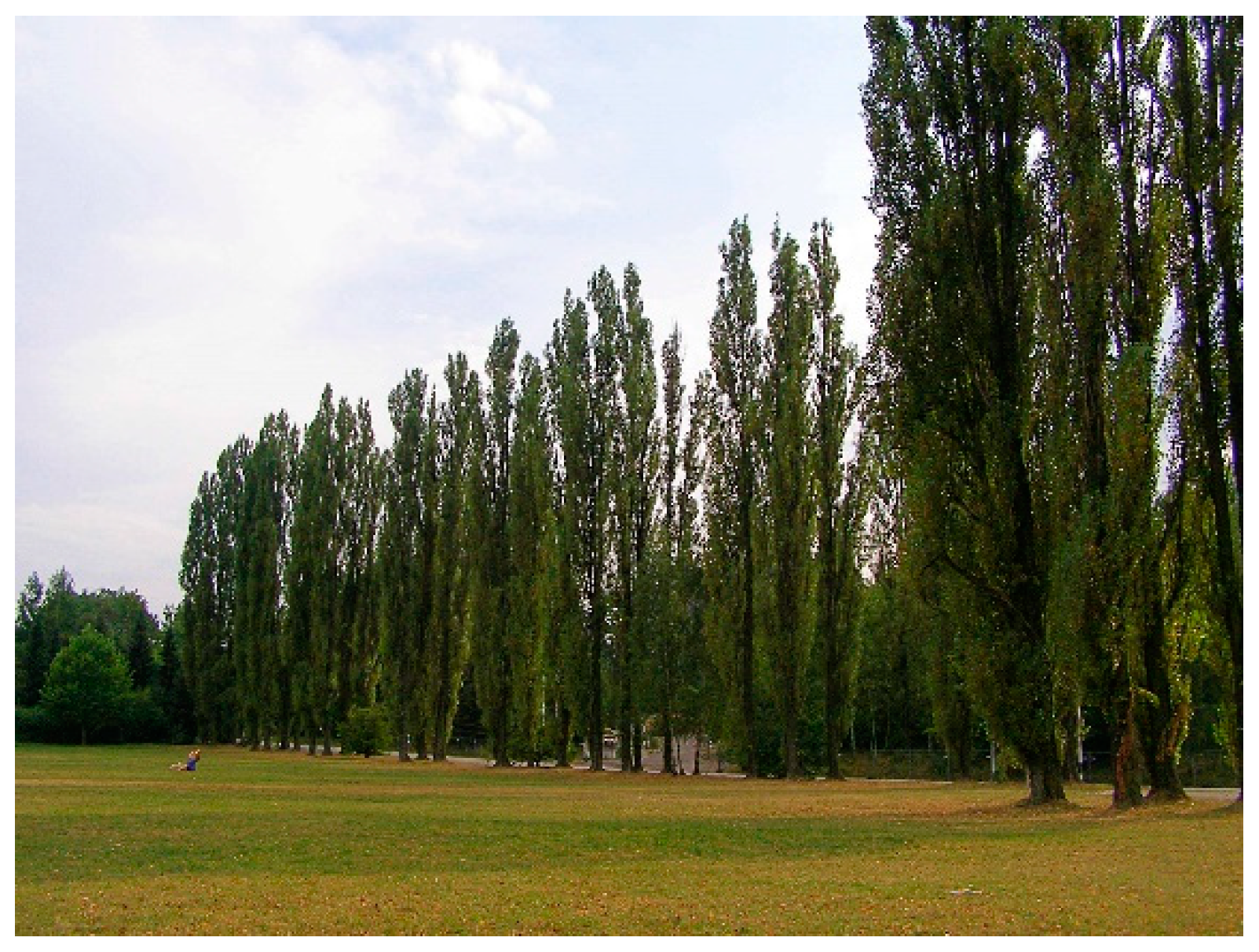
3.2. The Fast Increments of Poplars
3.3. The Short Lifespan of Poplars
- • typical botanical species, e.g . white poplar (P. alba L.) and black poplar (P. nigra L.);
- • the section of balsam poplars Tacamahaca and some cultivated varieties, e.g., P. simonii Carrière, P. maksymowiczii Henry, or balsam poplar hybrids, e.g.,: P. ×berolinensis Dippel) or hybrids like ‘NE 49’, ‘NE 42’ (Table 1).
3.4. The Use of Berlin Poplar in Afforestation of Urban Landscapes - Field Research
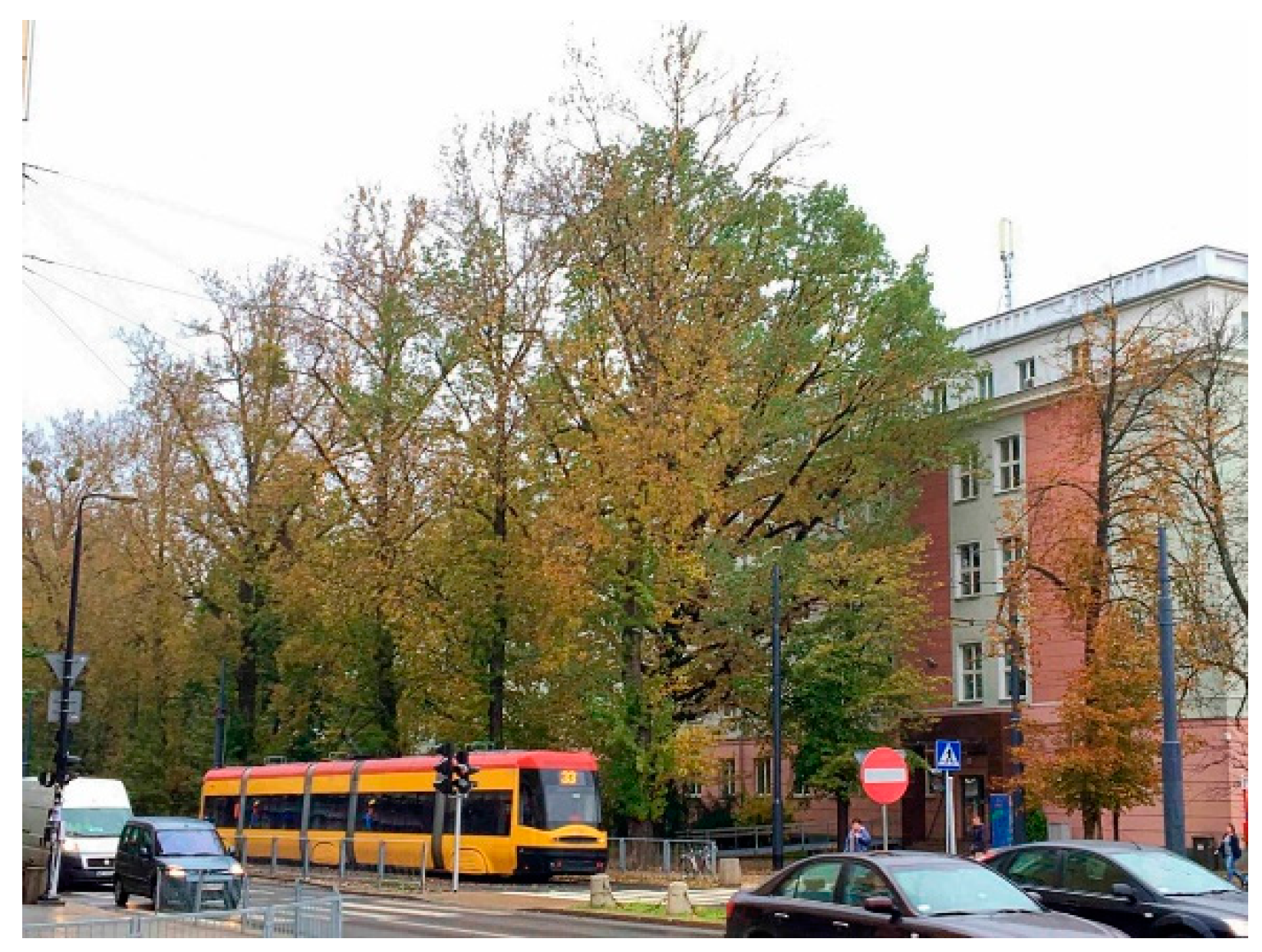
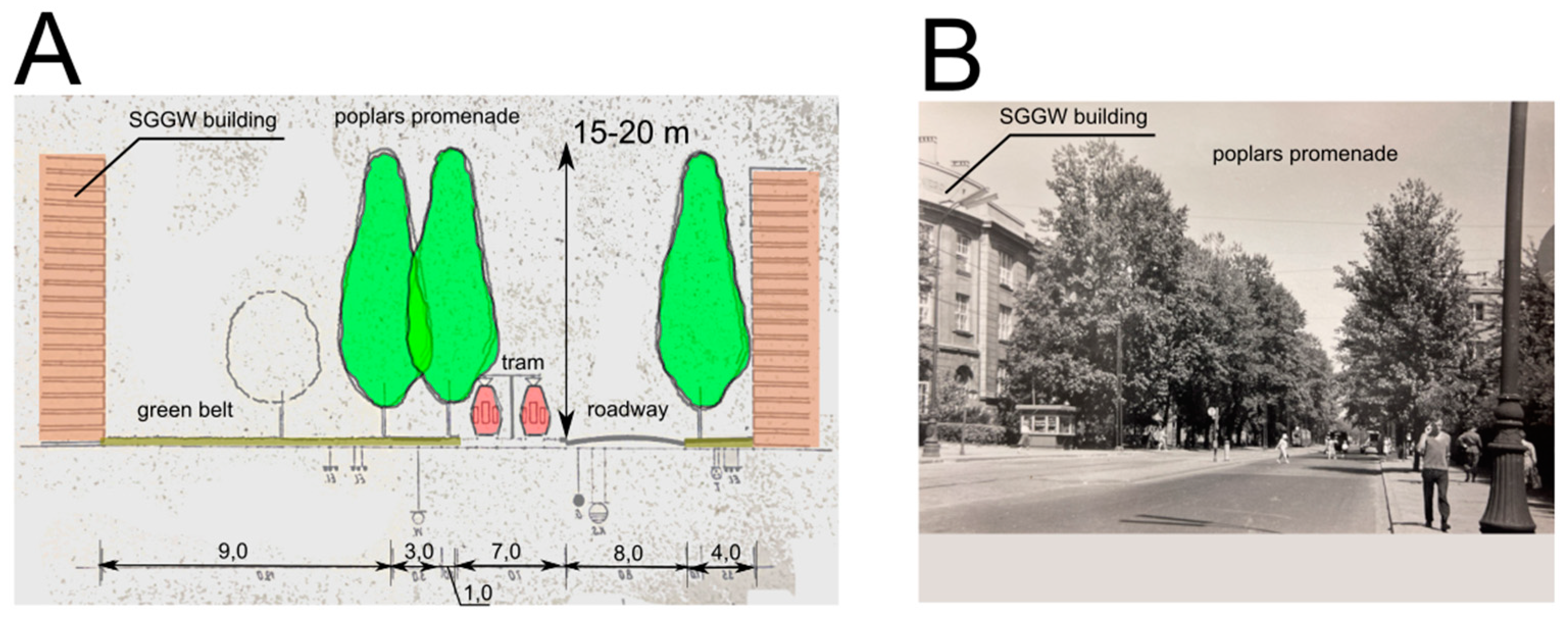
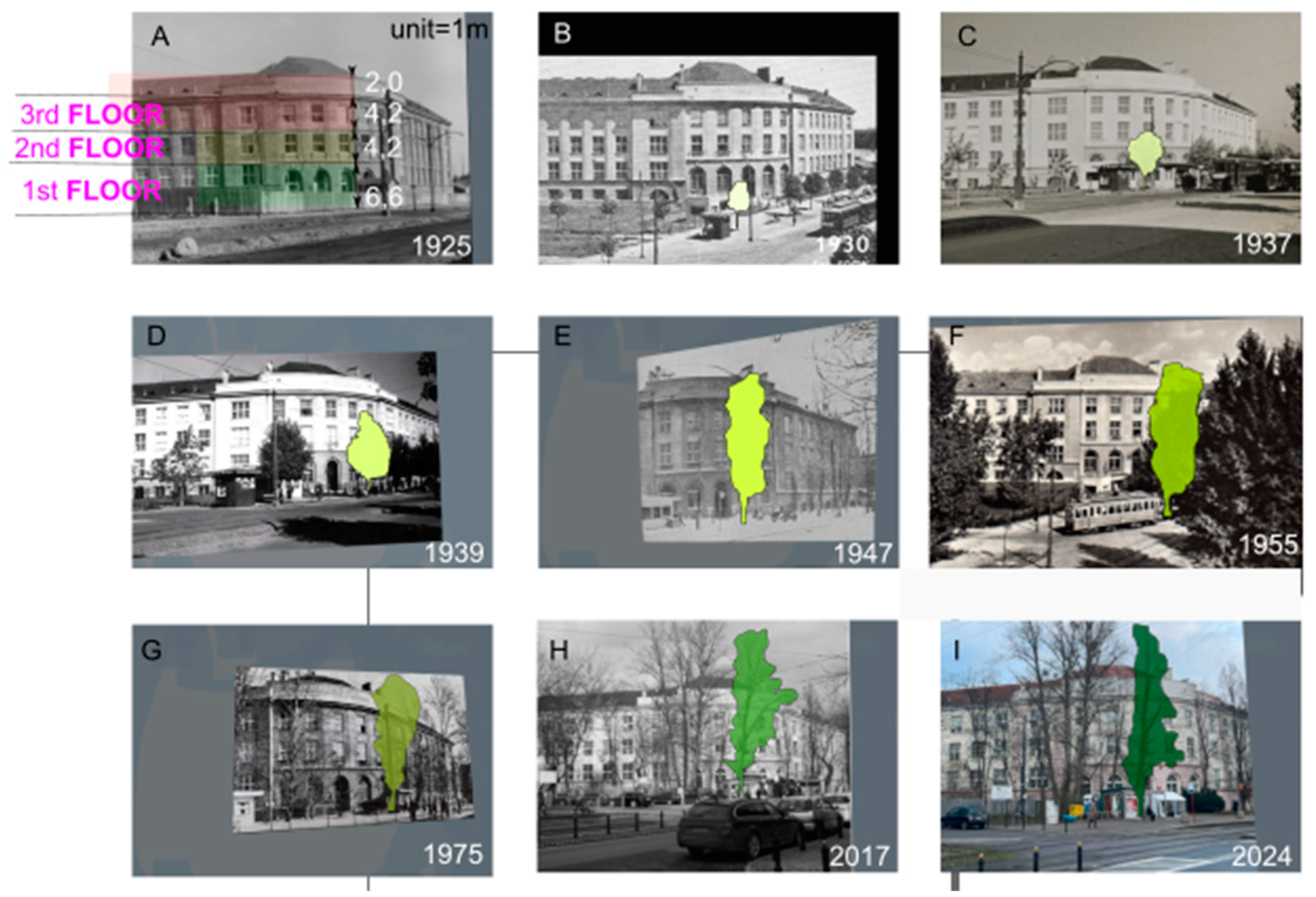
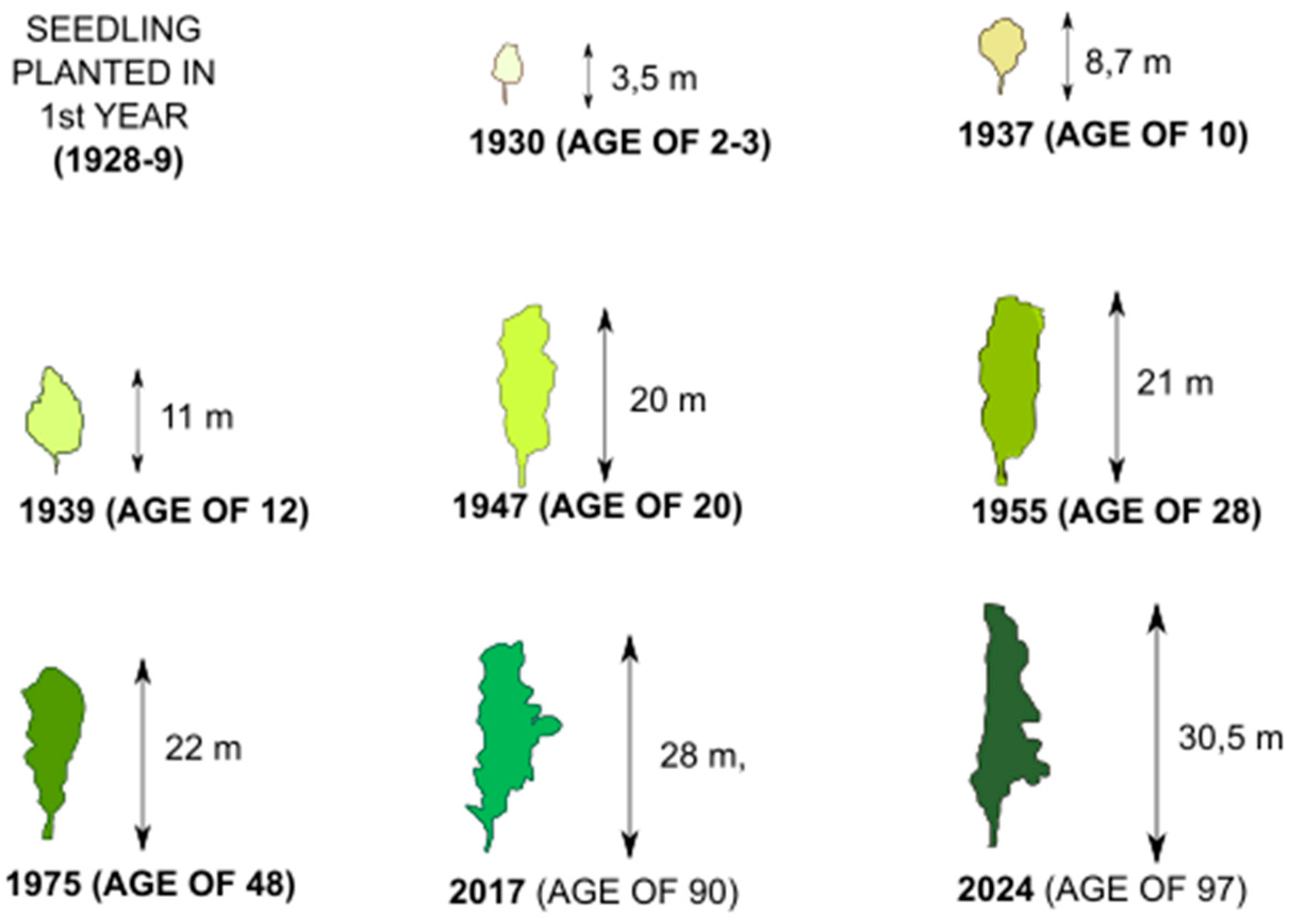
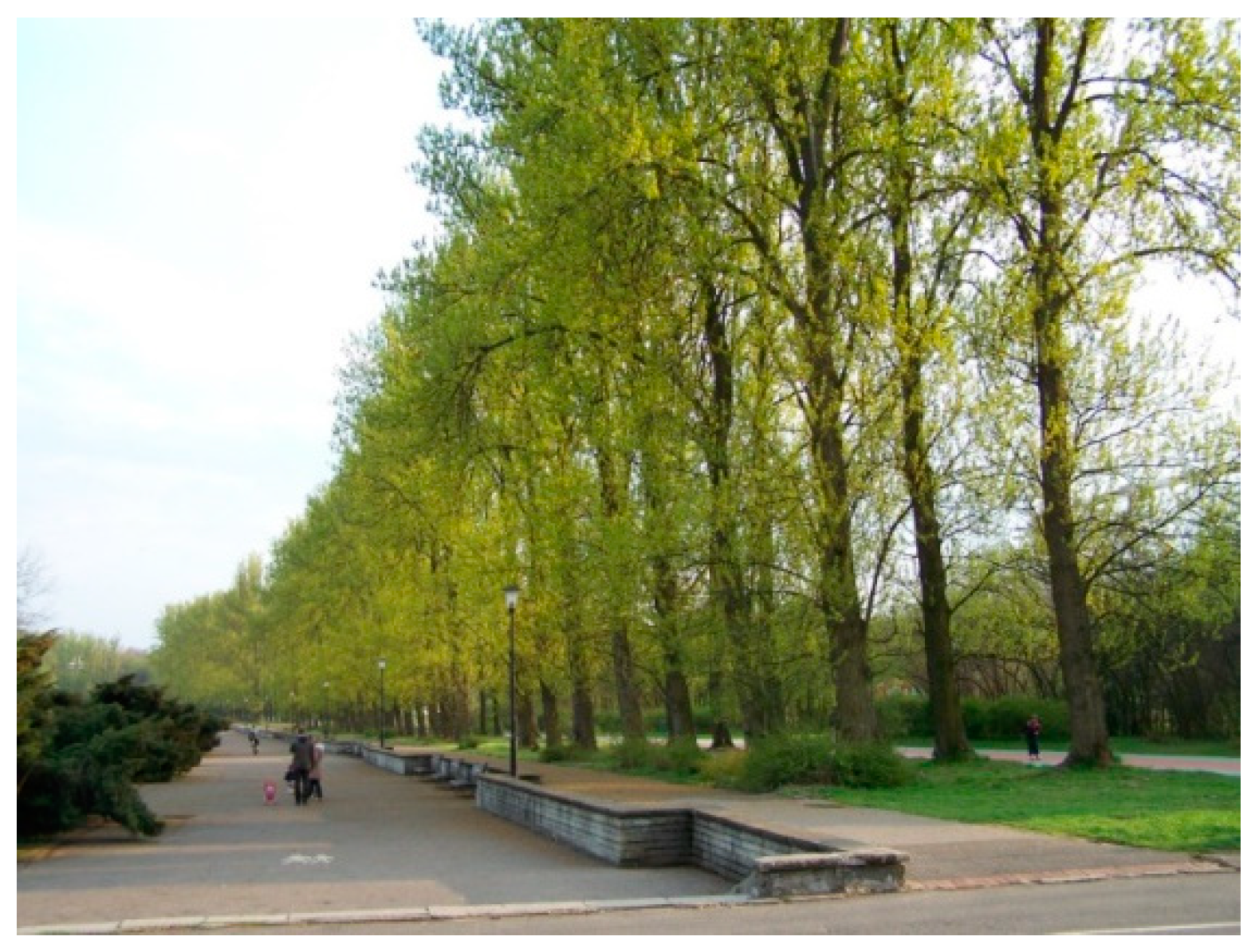
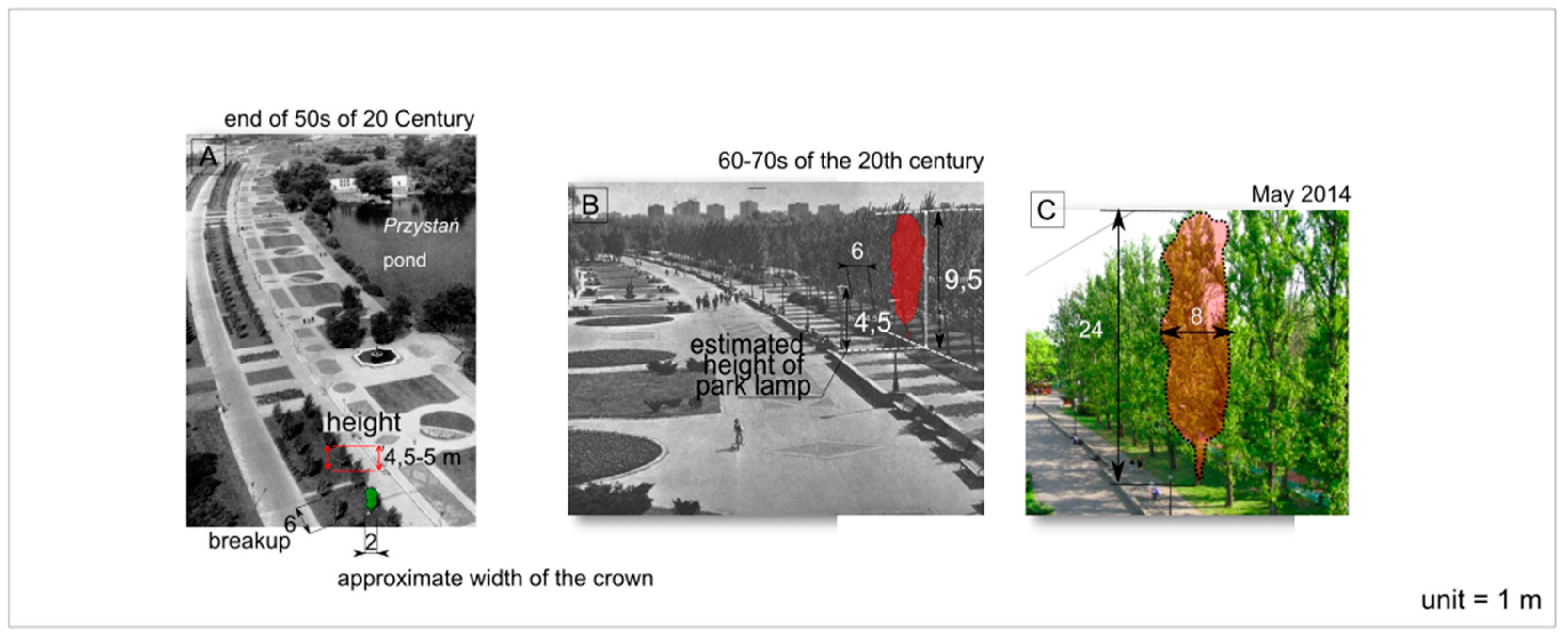
4. Discussion
4.1. Poplar in Cities as Suitable and Forgotten Trees in Urban Greenery
4.2. Problems of Poplars Database Analysis in Poland
5. Conclusions
- • The following conclusions highlight the complex interplay between the advantages and challenges of integrating poplars into urban landscapes, emphasizing the need for holistic and adaptive approaches to urban greening initiatives.
- • The diverse genus Populus sp. presents a promising avenue for enhancing urban greenery due to its rapid growth, adaptability, and contributions to environmental quality.
- • Despite their ecological benefits, the variable lifespans of different poplar species pose challenges that necessitate strategic urban planning and management practices.
- • Poplars contribute significantly to air quality improvement, carbon sequestration, soil stabilization, and biodiversity enhancement, enhancing the ecological resilience of urban areas.
- • Proper species selection, planting techniques, and maintenance strategies are crucial for maximizing the benefits of poplars while addressing concerns related to their shorter lifespans.
- • The shorter lifespan of certain poplar species presents challenges and opportunities, allowing for faster adaptation to changing urban conditions but requiring careful replanting and maintenance efforts.
- • Concerns surrounding allergenic tendencies, invasive characteristics, and the need for community acceptance highlight the complexities of integrating poplars into urban landscapes.
- • The integration of poplars in urban greenery initiatives necessitates comprehensive planning considering species diversity, spatial distribution, and long-term maintenance to ensure sustainability.
- • The dynamic nature of urban environments calls for innovative approaches that leverage the benefits of poplar while addressing challenges, allowing for adaptable and resilient green spaces.
- • Continued research is essential to develop comprehensive strategies that optimize the benefits of poplars in urban settings while mitigating risks associated with their variable lifespans and ecological characteristics.
- • Collaboration between researchers, urban planners, policymakers, and communities is crucial for harnessing poplar’s potential in urban environments, fostering sustainable and livable cities for future generations.
- • Poplars, because of their rapid growth, the enormous mass of these leaves and the rapid attainment of large sizes, have a positive impact on the city and the urban environment for phytomedicinal purposes (cleaning the surface with plants), shading, evaporation, oxygen production, cooling the atmosphere, providing a series of ecosystem services.
- • Polish examples of Berlin poplars show that the male form does not produce seeds in the ground and is practically a much better specimen for the city. This relationship confirms that if we choose a suitable variety of poplar for the proper purpose, we might quickly get very good results in biomass production and ascetic values of urban greenery.
Author Contributions
Funding
Data Availability Statement
Acknowledgments
Conflicts of Interest
References
- UNEP, 2007 UNEP (United Nations Environmental Programme) Annual Report, 2007. Available online: http://wedocs.unep.org/bitstream/handle/20.500.11822/7647/-UNEP%202007%20Annual%20Report-2008806.pdf?sequence=5&isAllowed=y (accessed on 17 July 2018).
- Krause Ch.L. Our visual landscape Managing the landscape under special consideration of visual aspects. Landscape and Urban Planning 2001, 54/2001, ss. 239-254. [CrossRef]
- European Environmental Agency Landscape fragmentation in Europe, Report No 2/2011, EEA, Copenhagen.
- Cui, Y., Xu, X., Dong, J., & Qin, Y. Influence of urbanization factors on surface urban heat island intensity: A comparison of countries at different developmental phases. Sustainability 2016, 8(8), 706. [CrossRef]
- Murray, R. Why cities need large parks [in] Murray, R. (ed.) Why Cities Need Large Parks. Large parks in large cities. Ed. Routledge, London, New York, 2021. pp 11-17.
- OECD Regions and Cities at a glance 2020. In OECD regions and cities at a glance. 2020. [CrossRef]
- Fischer, L. K., Neuenkamp, L., Lampinen, J., Tuomi, M., Alday, J. G., Bucharová, A., Cancellieri, L., Casado-Arzuaga, I., Čeplová, N., Cerveró, L., Deák, B., Eriksson, O., Fellowes, M. D. E., De Manuel, B. F., Filibeck, G., González-Guzmán, A., Hinojosa, M. B., Kowarik, I., Lumbierres, B., . . . Klaus, V. H. Public attitudes toward biodiversity-friendly greenspace management in Europe. Conservation Letters 2020, 13(4). [CrossRef]
- Dade, M. C., Mitchell, M. G. E., Brown, G., & Rhodes, J. R. The effects of urban greenspace characteristics and socio-demographics vary among cultural ecosystem services. Urban Forestry & Urban Greening 2020, 49, 126641. [CrossRef]
- Haaland, C., & Van Den Bosch, C. C. K. Challenges and strategies for urban green-space planning in cities undergoing densification: A review. Urban Forestry & Urban Greening 2015, 14(4), 760–771. [CrossRef]
- WHO. Urban green spaces: A brief for action. World Health Organization, Regional Office for Europe. Bonn. 2017. Retrieved on 1 October 2021 from https:// www. euro. who. int/ en/ health- topics/ envir onment- and- health/ urban- health/ publi catio ns/ 2017/urban- green- spaces- a- brief- for- action- 2017.
- Beckers, B., De Beeck, M. O., Weyens, N., Boerjan, W., & Vangronsveld, J. Structural variability and niche differentiation in the rhizosphere and endosphere bacterial microbiome of field-grown poplar trees. Microbiome 2017, 5(1). [CrossRef]
- De Rigo, D., Enescu, C. M., Houston Durrant, T., & Caudullo, G. Populus nigra in Europe: distribution, habitat, usage and threats. European atlas of forest tree species, 2016, 136-137.
- Vanden Broeck, A. EUFORGEN Technical Guidelines for genetic conservation and use for black poplar (Populus nigra). Bioversity International, 2003.
- Forman, R.T.T. Values of large-versus-small urban greenspaces and their arregement [in] Murray, R. (ed.) Why Cities Need Large Parks. Large parks in large cities. Ed. Routledge, London, New York, 2021. pp 18-43.
- Clark, P. Large urban parks and urban green space: a historical perspective [in] Murray, R. (ed.) Why Cities Need Large Parks. Large parks in large cities. Ed. Routledge, London, New York, 2021. pp 47-64.
- Schantz, P., Can nature really affect our health? A short review of studies [in] Murray, R. (ed.) Why Cities Need Large Parks. Large parks in large cities. Ed. Routledge, London, New York, 2021. pp 122-133.
- Bamwesigye, D., Fialová, J., Kupec, P., Łukaszkiewicz, J., & Fortuna-Antoszkiewicz, B. Forest Recreational services in the face of COVID-19 Pandemic stress. Land 2021, 10(12), 1347. [CrossRef]
- Bell, J.N.B.; Treshow, M.: Air pollution and plant life. [Zanieczyszczenie powietrza a życie roślin]. WNT, Warszawa, 2016.
- Slater, S.J.: Recommendations for keeping parks and green space accessible for mental and physical health during COVID-19 and other pandemics. Preventing Chronic Disease 2020, 17: 200204. [CrossRef]
- Ewing, R.; Schmid, T.; Killingsworth, R.; Zlot, A.; Raudenbush, S.: Relationship between Urban Sprawl and Physical Activity, Obesity and Morbidity. Marzluff, J.M. et al. (eds.); Urban Ecology, Boston, Springer 2008: 567-582.
- Łukaszkiewicz, J., Fortuna-Antoszkiewicz, B., Rosłon-Szeryńska, E., & Wiśniewski, P. The advantages of park’s stands for recreation bioclimate on the example of selected large scale parks in Europe. Journal of Landscape Management 2018, 9, 30–37. https://sgw0.bg.sggw.pl/F/?func=direct&doc_number=000048292&find_code=SYS&local_base=SGW03.
- Ordóñez, C., Beckley, T. M., Duinker, P. N., & Sinclair, A. J. Public values associated with urban forests: Synthesis of findings and lessons learned from emerging methods and cross-cultural case studies. Urban Forestry & Urban Greening 2017, 25, 74–84. [CrossRef]
- Moss, J. L., Doick, K. J., Smith, S. T., & Shahrestani, M. Influence of evaporative cooling by urban forests on cooling demand in cities. Urban Forestry & Urban Greening 2019, 37, 65–73. [CrossRef]
- Adams, J. F., Adeli, A., Hsu, C. Y., Harkess, R. L., Page, G. P., dePamphilis, C. W., Schultz, E. B., & Yüceer, Ç. Poplar maintains zinc homeostasis with heavy metal genes HMA4 and PCS1. Journal of Experimental Botany 2011, 62(11), 3737–3752. [CrossRef]
- Assad, M., Parelle, J., Cazaux, D., Gimbert, F., Chalot, M., & Tatin-Froux, F. Mercury uptake into poplar leaves. Chemosphere 2016, 146, 1–7. [CrossRef]
- Levei, L., Cadar, O., Băbălău-Fuss, V., Kovács, E., Török, A. I., Levei, E. A., & Ozunu, A. Use of black poplar leaves for the biomonitoring of air pollution in an urban agglomeration. Plants 2011, 10(3), 548. [CrossRef]
- Pajević, S., Borišev, M., Nikolić, N., Krstić, B., Pilipović, A., & Orlović, S. Phytoremediation capacity of poplar (Populus spp.) and willow (Salix spp.) clonesin relation to photosynthesis. Archives of Biological Sciences 2009, 61(2), 239–247. [CrossRef]
- Pilipović, A., Zalesny, R. S., Orlović, S., Drekić, M., Pekeč, S., Katanić, M., & Poljaković-Pajnik, L. Growth and physiological responses of three poplar clones grown on soils artificially contaminated with heavy metals, diesel fuel, and herbicides. International Journal of Phytoremediation 2019, 22(4), 436–450. [CrossRef]
- Silva, N. a. F., Lopes, M. I., Leitão, R. a. E., Silva, H. F. A., & Matos, M. Simultaneous monitoring of toxic metals on white poplar (Populus) by SWASV. Journal of the Brazilian Chemical Society 2005, 16(6a), 1275–1282. [CrossRef]
- Bamwesigye, D., Fialova, J., Kupec, P., Yeboah, E., Łukaszkiewicz, J., Fortuna-Antoszkiewicz, B., & Botwina, J. Urban Forest Recreation and Its Possible Role throughout the COVID-19 Pandemic. Forests 2023, 14, 1–16. [CrossRef]
- Fialová, J., Bamwesigye, D., Łukaszkiewicz, J., & Fortuna-Antoszkiewicz, B. Smart Cities Landscape and Urban Planning for Sustainability in Brno City. Land 2021, 10(8), 870. [CrossRef]
- Lo, A., Byrne, J., & Jim, C. Y. How climate change perception is reshaping attitudes towards the functional benefits of urban trees and green space: Lessons from Hong Kong. Urban Forestry & Urban Greening 2017, 23, 74–83. [CrossRef]
- Hewitt, C. N., Ashworth, K., & MacKenzie, A. R. Using green infrastructure to improve urban air quality (GI4AQ). AMBIO: A Journal of the Human Environment 2019, 49(1), 62–73. [CrossRef]
- Frosini, G., Amato, A., Mugnai, F., & Cinelli, F. The impact of trees on the UHI effect and urban environment quality: a case study of a district in Pisa, Italy. Atmosphere 2024, 15(1), 123. [CrossRef]
- Berland, A., Shiflett, S. A., Shuster, W. D., Garmestani, A. S., Goddard, H. C., Herrmann, D. L., & Hopton, M. E. The role of trees in urban stormwater management. Landscape and Urban Planning 2017, 162, 167–177. [CrossRef]
- Avdeev, Y., Gorovoy, S., Karpenko, E., Kudryavtsev, V., & Kozlovsky, L. Evaluation of the state of green plants under the conditions of urbanization. Periódico Tchê Química 2020, 17(34), 966-975. [CrossRef]
- Jin, R., Huang, J., & Xu, Y. Optimization of unmanned aerial vehicle application for measuring in complex urban green space. 2023. [CrossRef]
- Wu, J., Hu, J., Zhao, X., Sun, Y., & Hu, G. Role of tea plantations in the maintenance of bird diversity in anji county, china. Peerj 2023, 11, e14801. [CrossRef]
- Biamonte, E., Sandoval, L., Chacón, E., & Barrantes, G. Effect of urbanization on the avifauna in a tropical metropolitan area. Landscape Ecology 2010, 26(2), 183-194. [CrossRef]
- Muñoz, P., Garcia-Rodriguez, A., & Sandoval, L. Urbanization, habitat extension and spatial pattern, threaten a costa rican endemic bird. Revista De Biología Tropical 2020, 69(1). [CrossRef]
- Purwoko, A. Economic feasibility and development strategy of jabon (anthocephalus cadamba) cultivation in urban areas to meet the needs of timber and green open space. Iop Conference Series Earth and Environmental Science, 2023, 1241(1), 012105. [CrossRef]
- Mureva, A., Nyamugure, T., Masona, C., Mudyiwa, S., Makumbe, P., Muringayi, M., … & Nyamadzawo, G. Community perceptions towards the establishment of an urban forest plantation: a case of dzivaresekwa, zimbabwe. International Journal of Agricultural Research Innovation and Technology 2014, 4(1), 16-23. [CrossRef]
- Lüttge, U. and Buckeridge, M. Trees: structure and function and the challenges of urbanization. Trees 2020, 37(1), 9-16. [CrossRef]
- Östberg, J. and Sjögren, J. The linear index of tree appraisal (lita) model for economic valuation of large urban trees in sweden. Arboriculture & Urban Forestry 2016, 42(1). [CrossRef]
- Matos, P., Vieira, J., Rocha, B., Branquinho, C., & Pinho, P. Modeling the provision of air-quality regulation ecosystem service provided by urban green spaces using lichens as ecological indicators. Science of the Total Environment 2019, 665, 521–530. [CrossRef]
- Borowski, J., Fortuna-Antoszkiewicz, B., Łukaszkiewicz, J., & Rosłon-Szeryńska, E. Conditions for the effective development and protection of the resources of urban green infrastructure. E3S Web of Conferences, 45, 00010, 2018. [CrossRef]
- Graça, M., Queirós, C., Farinha-Marques, P., & Cunha, M. Street trees as cultural elements in the city: Understanding how perception affects ecosystem services management in Porto, Portugal. Urban Forestry & Urban Greening 2018, 30, 194–205. [CrossRef]
- Konijnendijk, C. C. Evidence-based guidelines for greener, healthier, more resilient neighbourhoods: Introducing the 3–30–300 rule. Journal of Forestry Research 2022, 34(3), 821–830. [CrossRef]
- Ziter, C., Pedersen, E. J., Kucharik, C. J., & Turner, M. G. Scale-dependent interactions between tree canopy cover and impervious surfaces reduce daytime urban heat during summer. Proceedings of the National Academy of Sciences of the United States of America, 2019, 116(15), 7575–7580. [CrossRef]
- Yang, J., Chang, Y., & Yan, P. Ranking the suitability of common urban tree species for controlling PM2.5 pollution. Atmospheric Pollution Research 2015, 6(2), 267–277. [CrossRef]
- Yang, Q., Wang, H., Wang, J., Lu, M., Liu, C., Xia, X., Yin, W., & Guo, H. PM2.5-bound SO42– absorption and assimilation of poplar and its physiological responses to PM2.5 pollution. Environmental and Experimental Botany 2018, 153, 311–319. [CrossRef]
- Kis, B., Avram, S., Pavel, I. Z., Lombrea, A., Buda, V., Dehelean, C., Şoica, C., Yerer, M. B., Bojin, F., Folescu, R., & Danciu, C. Recent Advances Regarding the Phytochemical and Therapeutic Uses of Populus nigra L. Buds. Plants 2020, 9(11), 1464. [CrossRef]
- Madejón, P., Ciadamidaro, L., Marañón, T., & Murillo, J. Long-Term biomonitoring of soil contamination using poplar trees: accumulation of trace elements in leaves and fruits. International Journal of Phytoremediation 2013, 15(6), 602–614. [CrossRef]
- Roy, S., Byrne, J., & Pickering, C. A systematic quantitative review of urban tree benefits, costs, and assessment methods across cities in different climatic zones. Urban forestry & urban greening 2012, 11(4), 351-363. [CrossRef]
- Bose, A., Moser, B., Rigling, A., Lehmann, M., Milcu, A., Peter, M., … & Gessler, A. Memory of environmental conditions across generations affects the acclimation potential of scots pine. Plant Cell & Environment 2020, 43(5), 1288-1299. [CrossRef]
- Pretzsch, H., Biber, P., Uhl, E., Dahlhausen, J., Schütze, G., Perkins, D., … & Lefer, B. Climate change accelerates growth of urban trees in metropolises worldwide. Scientific Reports 2017, 7(1). [CrossRef]
- Crous-Duran, J., Graves, A., Jalón, S., Kay, S., Tomé, M., Burgess, P., … & Palma, J. Quantifying regulating ecosystem services with increased tree densities on european farmland. Sustainability 2020, 12(16), 6676. [CrossRef]
- Zhang, M., Yuan, N., & Li, M. Evaluation of the growth, adaption, and ecosystem services of two potentially-introduced urban tree species in guangzhou under drought stress. Scientific Reports 2023, 13(1). [CrossRef]
- Vaz, A., Castro-Díez, P., Godoy, Ó., Alonso, Á., Vilà, M., Saldaña, A., … & Honrado, J. An indicator-based approach to analyse the effects of non-native tree species on multiple cultural ecosystem services. Ecological Indicators 2018, 85, 48-56. [CrossRef]
- Lima, I., Scariot, A., & Giroldo, A. Impacts of the implementation of silvopastoral systems on biodiversity of native plants in a traditional community in the brazilian savanna. Agroforestry Systems 2016, 91(6), 1069-1078. [CrossRef]
- Gawroński, S.W. Phytoremediation Role of Plants in Urbanized Areas; Nowak, G., Kubus, M., Sobisz, Z., Eds.; Trees and Shrubs in Environmental Reclamation, Mat. IX Zjazdu Polskiego Towarzystwa Dendrologicznego. Konferencja Naukowa, Wirty-Ustka, 19-22 września 2018 r.; Polish Dendrology Society: Szczecin, Poland; 2018: 19–27.
- Łukaszkiewicz, J. Zadrzewienia w krajobrazie miasta: wybrane aspekty kształtowania struktury i funkcji [Trees in the city landscape: selected aspects of shaping the structure and function]. Ed. SGGW, Warsaw, Poland, 2019.
- Łukaszkiewicz, J., & Fortuna-Antoszkiewicz, B. The influence of woodlots on the photoclimate of green areas and the quality of recreation. W J. Fialová (Red.), Public recreation and landscape protection – with environment hand in hand… (T. 13, s. 385–389). Mendel University in Brno, 2022. [CrossRef]
- Popek, R.; Gawronska, H.; Gawronski, S.W. The level of particulate matter on foliage depends on the distance from the source of emission. Int J Phytoremediation 2015, 17(12): 1262-1268. [CrossRef]
- Sgrigna, G., Sæbø, A., Gawroński, S., Popek, R., & Calfapietra, C. Particulate Matter deposition on Quercus ilex leaves in an industrial city of central Italy. Environmental Pollution 2015, 197, 187–194. [CrossRef]
- Chambers-Ostler, A., Walker, H., & Doick, K. J. The role of the private tree in bringing diversity and resilience to the urban forest. Urban Forestry & Urban Greening 2024, 91, 127973. [CrossRef]
- Gillner, S., Vogt, J., Tharang, A., Dettmann, S., & Roloff, A. Role of street trees in mitigating effects of heat and drought at highly sealed urban sites. Landscape and Urban Planning 2015, 143, 33–42. [CrossRef]
- Jim, C. Y. Urban Heritage Trees: Natural-Cultural Significance Informing management and Conservation. In Advances in 21st century human settlements, 2017, pp. 279–305. [CrossRef]
- Jacobsen, R. M., Birkemoe, T., Evju, M., Skarpaas, O., & Sverdrup-Thygeson, A. Veteran trees in decline: Stratified national monitoring of oaks in Norway. Forest Ecology and Management 2023, 527, 120624. [CrossRef]
- Carmichael, C., & McDonough, M. H. The trouble with trees? Social and political dynamics of street tree-planting efforts in Detroit, Michigan, USA. Urban Forestry & Urban Greening 2018, 31, 221–229. [CrossRef]
- Nowak, D. J., & Aevermann, T. Tree compensation rates: Compensating for the loss of future tree values. Urban Forestry & Urban Greening 2019, 41, 93–103. [CrossRef]
- Riedman, E., Roman, L. A., Pearsall, H., Maslin, M., Ifill, T., & Dentice, D. Why don’t people plant trees? Uncovering barriers to participation in urban tree planting initiatives. Urban Forestry & Urban Greening 2022, 73, 127597. [CrossRef]
- Hurley, A., & Heinrich, I. Assessing urban-heating impact on street tree growth in Berlin with open inventory and environmental data. Urban Ecosystems 2023. [CrossRef]
- Moffat, A. Communicating the benefits of urban trees: A critical review. Arboricultural Journal 2016, 38(2), 64–82. [CrossRef]
- Moffat, A., Ambrose-Oji, B., Clarke, T., O’Brien, L., & Doick, K. J. Public attitudes to urban trees in Great Britain in the early 2020 s. Urban Forestry & Urban Greening 2024, 91, 128177. [CrossRef]
- Schroeder, H., Flannigan, J., & Coles, R. Residents’ attitudes toward street trees in the UK and U.S. communities. Arboriculture and Urban Forestry 2006, 32(5), 236–246. [CrossRef]
- Łukaszkiewicz, J., Fortuna-Antoszkiewicz, B., Rosłon-Szeryńska, E., & Wiśniewski, P. Poplars’ shelterbelts and woodlots in the cultural landscape of Poland - functions, application and maintenance. W J. Fialová (Red.), Public recreation and landscape protection - with sense hand in hand... : conference proceeding : 13th - 15th May 2019, Křtiny (s. 281–285). Mendel University in Brno, 2019.
- Endreny, T. Strategically growing the urban forest will improve our world. Nature Communications 2018, 9(1). [CrossRef]
- Livesley, S., McPherson, E., & Calfapietra, C. The urban forest and ecosystem services: impacts on urban water, heat, and pollution cycles at the tree, street, and city scale. Journal of Environmental Quality 2016, 45(1), 119-124. [CrossRef]
- Hiemstra, J. A., Schoenmaker-van der Bijl, E., Tonneijck, A. E. G., & Hoffman, M. H. A. Trees: relief for the city. Plant Publicity Holland. 2008.
- Avşar, M. D., & Ok, T. Using poplars (Populus L.) in urban afforestation: KAHRAMANMARAŞ sample. Turkish Journal of Forestry, 2010, 11(2), 127–135. https://dergipark.org.tr/tr/download/article-file/195755.
- Fortuna-Antoszkiewicz, B., Łukaszkiewicz, J., & Wiśniewski, P. Stan zachowania i walory krajobrazowe przywodnych zadrzewień topolowych Kanału Żerańskiego - metodologiczne studium przypadku. MAZOWSZE Studia Regionalne, 2018, 81–102. [CrossRef]
- Zalesny, R. and Headlee, W. Developing woody crops for the enhancement of ecosystem services under changing climates in the north central united states. Journal of Forest and Environmental Science 2015, 31(2), 78-90. [CrossRef]
- Levei, L., Cadar, O., Babalau-Fuss, V., Kovacs, E., Török, A., Levei, E., … & Ozunu, A. Use of black poplar leaves for the biomonitoring of air pollution in an urban agglomeration. Plants 2021, 10(3), 548. [CrossRef]
- Molnár, V., Tőzsér, D., Szabó, S., Tóthmérész, B., & Simon, E. Use of leaves as bioindicator to assess air pollution based on composite proxy measure (apti), dust amount and elemental concentration of metals. Plants 2020, 9(12), 1743. [CrossRef]
- Liu, Y., Yang, Z., Zhu, M., & Yin, J. Role of plant leaves in removing airborne dust and associated metals on beijing roadsides. Aerosol and Air Quality Research 2017, 17(10), 2566-2584. [CrossRef]
- Chen, S., Yu, Y., Wang, X., Wang, S., Zhang, T., Zhou, Y., … & Chen, S. Chromosome-level genome assembly of a triploid poplar populus alba ‘berolinensis’. Molecular Ecology Resources 2023, 23(5), 1092-1107. [CrossRef]
- Fineschi, S. and Loreto, F. A survey of multiple interactions between plants and the urban environment. Frontiers in Forests and Global Change 2020, 3. [CrossRef]
- Luo, X., Yu, S., Zhu, Y., & Li, X. Trace metal contamination in urban soils of china. The Science of the Total Environment, 2021, 421-422, 17-30. [CrossRef]
- Kroeger, T., Escobedo, F., Hernandez, J., Varela, S., Delphin, S., Fisher, J., … & Waldron, J. Reforestation as a novel abatement and compliance measure for ground-level ozone. Proceedings of the National Academy of Sciences, 2014, 111(40). [CrossRef]
- Urgilez-Clavijo, A., Fernández, J., Rivas-Tabares, D., & Tarquis, A. Linking deforestation patterns to soil types: a multifractal approach. European Journal of Soil Science 2020, 72(2), 635-655. [CrossRef]
- Cardoso, M., Alves, H., Costa, I., & Vieira, T. Anthropogenic actions and socioenvironmental changes in lake of juá, brazilian amazonia. Sustainability 2021, 13(16), 9134. [CrossRef]
- Millward, A. and Sabir, S. Benefits of a forested urban park: what is the value of allan gardens to the city of toronto, canada?. Landscape and Urban Planning 2011, 100(3), 177-188. [CrossRef]
- Pavlacky, D., Goldizen, A., Prentis, P., Nicholls, J., & Lowe, A. A landscape genetics approach for quantifying the relative influence of historic and contemporary habitat heterogeneity on the genetic connectivity of a rainforest bird. Molecular Ecology 2009, 18(14), 2945-2960. [CrossRef]
- Sari, N., Indra, T., & Kushardono, D. Urban vegetation quality assessment using vegetation index and leaf area index from spot 7 data with fuzzy logic algorithm. International Journal on Advanced Science Engineering and Information Technology 2022, 12(2), 738. [CrossRef]
- Rosier, C., Polson, S., D’Amico, V., Kan, J., & Trammell, T. Urbanization pressures alter tree rhizosphere microbiomes. Scientific Reports 2021, 11(1). [CrossRef]
- Assad, M., Chalot, M., Tatin-Froux, F., Bert, V., & Parelle, J. Trace metal(oid) accumulation in edible crops and poplar cuttings grown on dredged sediment enriched soil. Journal of Environmental Quality 2018, 47(6), 1496-1503. [CrossRef]
- Piotrowska, N., Czachorowski, S., & Stolarski, M. Ground beetles (carabidae) in the short-rotation coppice willow and poplar plants—synergistic benefits system. Agriculture 2020, 10(12), 648. [CrossRef]
- Liu, L. and Zhang, Y. Urban heat island analysis using the landsat tm data and aster data: a case study in hong kong. Remote Sensing 2011, 3(7), 1535-1552. [CrossRef]
- Tang, C. A study of the urban heat island effect in guangzhou. Iop Conference Series Earth and Environmental Science, 2022, 1087(1), 012015. [CrossRef]
- Li, B., Liu, Z., Nan, Y., Li, S., & Yang, Y. Comparative analysis of urban heat island intensities in chinese, russian, and dprk regions across the transnational urban agglomeration of the tumen river in northeast asia. Sustainability 2018, 10(8), 2637. [CrossRef]
- Lee, D., Oh, K., & Seo, J. An analysis of urban cooling island (uci) effects by water spaces applying uci indices. International Journal of Environmental Science and Development 2016, 7(11), 810-815. [CrossRef]
- Zhou, L., Dickinson, R., Tian, Y., Fang, J., Li, Q., Kaufmann, R., … & Myneni, R. Evidence for a significant urbanization effect on climate in china. Proceedings of the National Academy of Sciences, 2004, 101(26), 9540-9544. [CrossRef]
- Yang, Y., Fan, S., Ma, J., Zheng, W., Song, L., & Wei, C. Spatial and temporal variation of heat islands in the main urban area of zhengzhou under the two-way influence of urbanization and urban forestry. Plos One 2022, 17(8), e0272626. [CrossRef]
- Simiele, M., Zio, E., Montagnoli, A., Terzaghi, M., Chiatante, D., Scippa, G., … & Trupiano, D. Biochar and/or compost to enhance nursery-produced seedling performance: a potential tool for forest restoration programs. Forests 2022, 13(4), 550. [CrossRef]
- Jia, D., Li, X., Zhang, Y., Feng, Y., & Liu, D. Analysis on water use strategies of natural poplar in hunshandake sandy land, china. Environmental Progress & Sustainable Energy 2021, 40(3). [CrossRef]
- Wang, G., Deng, F., Xu, W., Chen, H., & Ruan, H. Poplar plantations in coastal china: towards the identification of the best rotation age for optimal soil carbon sequestration. Soil Use and Management 2016, 32(3), 303-310. [CrossRef]
- Xia, J., Zhang, S., Li, T., Liu, X., & Guangcan, Z. Effect of continuous cropping generations on each component biomass of poplar seedlings during different growth periods. The Scientific World Journal, 2014, 1-9. [CrossRef]
- Scotti, R., D’Ascoli, R., Cáceres, M., Bonanomi, G., Sultana, S., Cozzolino, L., … & Rao, M. Combined use of compost and wood scraps to increase carbon stock and improve soil quality in intensive farming systems. European Journal of Soil Science 2015, 66(3), 463-475. [CrossRef]
- Wang, K., Ri-sheng, Z., Song, L., & Yan, T. Comparison of c:n:p stoichiometry in the plant–litter–soil system between poplar and elm plantations in the horqin sandy land, china. Frontiers in Plant Science 2021, 12. [CrossRef]
- Guarino, F., Improta, G., Triassi, M., Cicatelli, A., & Castiglione, S. Effects of zinc pollution and compost amendment on the root microbiome of a metal tolerant poplar clone. Frontiers in Microbiology 2020, 11. [CrossRef]
- Ferré, C., Comolli, R., Leip, A., & Seufert, G. Forest conversion to poplar plantation in a lombardy floodplain (italy): effects on soil organic carbon stock. Biogeosciences 2014, 11(22), 6483-6493. [CrossRef]
- Wang, G., Dong, Y., Liu, X., Yao, G., Yu, X., & Yang, M. The current status and development of insect-resistant genetically engineered poplar in china. Frontiers in Plant Science 2018, 9. [CrossRef]
- Shahid, M., Dumat, C., Khalid, S., Schreck, E., Xiong, T., & Niazi, N. Foliar heavy metal uptake, toxicity and detoxification in plants: a comparison of foliar and root metal uptake. Journal of Hazardous Materials 2017, 325, 36-58. [CrossRef]
- Assad, M., Chalot, M., Tatin-Froux, F., Bert, V., & Parelle, J. Trace metal(oid) accumulation in edible crops and poplar cuttings grown on dredged sediment enriched soil. Journal of Environmental Quality 2018, 47(6), 1496-1503. [CrossRef]
- Camarero, J. J., De Andrés, E. G., Colangelo, M., & De Jaime Loren, C. Growth history of pollarded black poplars in a continental Mediterranean region: A paradigm of vanishing landscapes. Forest Ecology and Management, 2022, 517, 120268. [CrossRef]
- Hejmanowski S., Milewski J., Terpiński Z., Poradnik zadrzewieniowca, PWRiL, Warszawa, 1964.
- Jakuszewski T. Topola w zadrzewieniu kraju [w:] Topole (Populus L.). Nasze Drzewa Leśne, S. Białobok (red.). Monografie Popularnonaukowe, Tom XII s. 463-470, Zakład Dendrologii i Arboretum Kórnickie w Kórniku k. Poznania. PWN, Warszawa – Poznań, 1973.
- Zabielski, 1973. Uprawa topoli w Polsce [w:] S. Białobok (red.), Topole (Populus L.). Nasze Drzewa Leśne. Monografie Popularnonaukowe, 12, Zakład Dendrologii i Arboretum Kórnickie w Kórniku, PWN, Warszawa – Poznań, s. 413-462.
- Çölkesen, İ., Kavzoğlu, T., Ateşoğlu, A., Tonbul, H., & Öztürk, M. Y. Multi-seasonal evaluation of hybrid poplar (P. Deltoides) plantations using Worldview-3 imagery and State-Of-The-Art ensemble learning algorithms. Advances in Space Research, 2023, 71(7), 3022–3044. [CrossRef]
- Li, J., Gao, K., Yang, X., Guo, B., Xue, Y., Miao, D., … & An, X. Comprehensive analyses of four ptonfyc genes from populus tomentosa and impacts on flowering timing. International Journal of Molecular Sciences 2022, 23(6), 3116. [CrossRef]
- Chen, S., Yu, Y., Wang, X., Wang, S., Zhang, T., Zhou, Y., … & Chen, S. Chromosome-level genome assembly of a triploid poplar populus alba ‘berolinensis’. Molecular Ecology Resources 2023, 23(5), 1092-1107. [CrossRef]
- Wilkaniec, A., Borowiak-Sobkowiak, B., Irzykowska, L., Bres, W., Świerk, D., Pardela, Ł., … & Wielgus, K. Biotic and abiotic factors causing the collapse of robinia pseudoacacia l. veteran trees in urban environments. Plos One 2021 16(1), e0245398. [CrossRef]
- Peng, Y., Zhou, Z., Zhang, Z., Yu, X., Zhang, X., & Du, K. Molecular and physiological responses in roots of two full-sib poplars uncover mechanisms that contribute to differences in partial submergence tolerance. Scientific Reports 2018, 8(1). [CrossRef]
- Chen, S., Yu, Y., Wang, X., Wang, S., Zhang, T., Meng, N., … & Chen, S. (2022). Chromosome-level genome assembly of a triploid poplar populus alba ’berolinensis’.. [CrossRef]
- Hacquard, S., Pêtre, B., Frey, P., Hecker, A., Rouhier, N., & Duplessis, S. The poplar-poplar rust interaction: insights from genomics and transcriptomics. Journal of Pathogens, 2011, 1-11. [CrossRef]
- Seneta W., Dolatowski J., Dendrologia, PWN, Warszawa, 2012.
- Čížková, L. (Forestry and Game Management Research Institute, Jílové u Prahy, Czechia). Personal communication, 2021.
- Piasecki J.K. Tereny zieleni dzielnicy Warszawa-Ochota [Green areas in Warsaw’s Ochota district]; MSc Thesis - manuscript in collection of Landscape Architecture Department, WULS-SGGW, Warsaw, 1974 (in Polish).
- Zielonko A. Drzewostan przyuliczny w kolizji z infrastrukturą [Street tree stand colliding with infrastructure] Journal Ogrodnictwo 1977, RXIV Nr.10, pp 269-273 (in Polish).
- Historical photos of Rakowiecka street in Warsaw - Photo A-H: FotoPolska.eu; https://warszawa.fotopolska.eu [access: 19.10.2019].
- Fortuna-Antoszkiewicz, B., Łukaszkiewicz, J., Wisniewski, P. Przekształcenia kompozycji szaty roślinnej Parku Śląskiego w Chorzowie po 60 latach [The transformation of vegetation’s composition 60 years after the establishment of Silesia Park]. Urbanism and Architecture Files of the Polish Academy of Sciences Kraków Branch, Vol. XLV, 2017, 193–215 PL eISSN 2450-0038.
- Łukaszkiewicz, J., Fortuna-Antoszkiewicz, B., Wiśniewski, P. Silesia Park, Chorzów, Poland in: Murray R. (ed.) Why Cities Need Large Parks. Routledge, London, New York / 2021, pp: 264-273, ISBN 978-1-03-207293-7.
- Niemirski W. Schlesischer Kulturpark in Kattowitz. Baumeister No7, 1971, pp. 826-827.
- Knobelsdorf W. (red.) Oaza pod rudym obłokiem: Śląski Park Kultury i Wypoczynku. Wyd. 1., Wyd. 1972, “Śląsk”, Katowice.
- Ghezehei, S.B.; Nichols, E.G.; Maier, C.A.; Hazel, D.W. Adaptability of Populus to Physiography and Growing Conditions in the Southeastern USA. Forests 2019, 10, 118. [CrossRef]
- Fang, S., Liu, Y., Yue, J., Tian, Y., & Xu, X. Assessments of growth performance, crown structure, stem form and wood property of introduced poplar clones: Results from a long-term field experiment at a lowland site. Forest Ecology and Management 2021, 479, 118586. [CrossRef]
- Riccioli, F.; Guidi Nissim, W.; Masi, M.; Palm, E.; Mancuso, S.; Azzarello, E. Modeling the Ecosystem Services Related to Phytoextraction: Carbon Sequestration Potential Using Willow and Poplar. Appl. Sci. 2020, 10, 8011. [CrossRef]
- Fang, S., Xue, J., & Tang, L. Biomass production and carbon sequestration potential in poplar plantations with different management patterns. Journal of environmental management 2007, 85(3), 672-679. [CrossRef]
- Khurana, D. K. Mitigating Wood Shortages Through a People Friendly Tree-Poplar. AGE, 7(9), 11.
- Konijnendijk, C. C., & Gauthier, M. Urban forestry for multifunctional urban land use. Cities farming for the future: Agriculture for green and productive cities. R. van Veenhuizen, Ed. Rome: RUAF Foundation, 2006, 414-416.
- Miller, R. W., Hauer, R. J., & Werner, L. P. Urban forestry: planning and managing urban greenspaces. Waveland press, 2015.
- McCarthy, M. A., & Possingham, H. P. Active adaptive management for conservation. Conservation Biology 2007, 21(4), 956-963. [CrossRef]
- Brancalion, P. H., & Holl, K. D. Guidance for successful tree planting initiatives. Journal of Applied Ecology 2020, 57(12), 2349-2361. [CrossRef]
- D’Amato, A. W., Palik, B. J., Raymond, P., Puettmann, K. J., & Girona, M. M. Building a Framework for Adaptive Silviculture Under Global Change. In Boreal Forests in the Face of Climate Change: Sustainable Management, 2023 (pp. 359-381). Cham: Springer International Publishing.
- Rauf, H. A., Wolff, E., & Hamel, P. Climate Resilience in Informal Settlements: The Role of Natural Infrastructure: A Focus on Climate Adaptation. In The Palgrave Encyclopedia of Urban and Regional Futures (pp. 269-277). Cham: Springer International Publishing. 2023.
- Coseo, P., & Hamstead, Z. Just, nature-based solutions as critical urban infrastructure for cooling and cleaning airsheds. Nature-Based Solutions for Cities, 2023, 106-146.
- Maouni, Y., Boubekraoui, H., Taaouati, M., Maouni, A., & Draoui, M. Assessment of Urban Outdoor Comfort Variation in a Northwestern Moroccan City-Toward the Implementation of Effective Mitigation Strategies. Ecological Engineering & Environmental Technology (EEET) 2023, 24(7). [CrossRef]
- D’Amato, G., Girard, L. F., Murena, F., & Nocca, F. 14. Climate change, air pollution and circular city model: a proposal for the urban sustainable development of the historical center of Naples (Italy). Reconnecting the city with nature and history: Towards circular regeneration strategies, 2023, 367.
- Nádasy, L. Z., Valánszki, I., & Sárospataki, M. Space compositional aspects regarding the importance of trees in the urban landscape. Plants 2023, 12(13), 2581. [CrossRef]
- Deakin, R. Poplar Stories: Whiteness, Class Loss and the Affective Infrastructure of Urban Regeneration in East London’s Former Docklands, 2023 (Doctoral dissertation, Goldsmiths, University of London).
- Ma, R., Luo, Y., & Furuya, K. Gender Differences and Optimizing Women’s Experiences: An Exploratory Study of Visual Behavior While Viewing Urban Park Landscapes in Tokyo, Japan. Sustainability, 2023, 15(5), 3957. [CrossRef]
- Du, K., Jiang, S., Chen, H., Xia, Y., Guo, R., Ling, A., ... & Kang, X. Spatiotemporal miRNA and transcriptomic network dynamically regulate the developmental and senescence processes of poplar leaves. Horticulture Research 2023, 10(10). [CrossRef]
- Vornicu, L., Okros, A., Șmuleac, L., Pascalau, R., Petcov, A., Zoican, Ș., ... & Zoican, C. Energetic poplars and their importance for the environment. Research Journal of Agricultural Science 2023 55(2).
- Fuertes, A., Oliveira, N., Pérez-Cruzado, C., Cañellas, I., Sixto, H., & Rodríguez-Soalleiro, R. Adapting 3-PG foliar variables to deciduous trees in response to water restriction: poplar short rotation plantations under Mediterranean conditions. Forestry: An International Journal of Forest Research 2024, 97(1), 107-119. [CrossRef]
- Aitchison, E. W., Kelley, S. L., Alvarez, P. J., & Schnoor, J. L. Phytoremediation of 1, 4-dioxane by hybrid poplar trees. Water Environment Research 2000, 72(3), 313-321. [CrossRef]
- Goodarzi, G. R., & Ahmadloo, F. Assessment of quantitative and qualitative characteristics of traditional poplar plantations production in Markazi province. Forest and Wood Products 2022, 75(3), 201-216. [CrossRef]
- Buchwald, A. Dentrometria [Dentrometry]. Chapter 4.2. Określanie przyrostu drzewa i drzewostanu, Wydawnictwo SGGW, Warszawa pp.170-176 (in Polish).
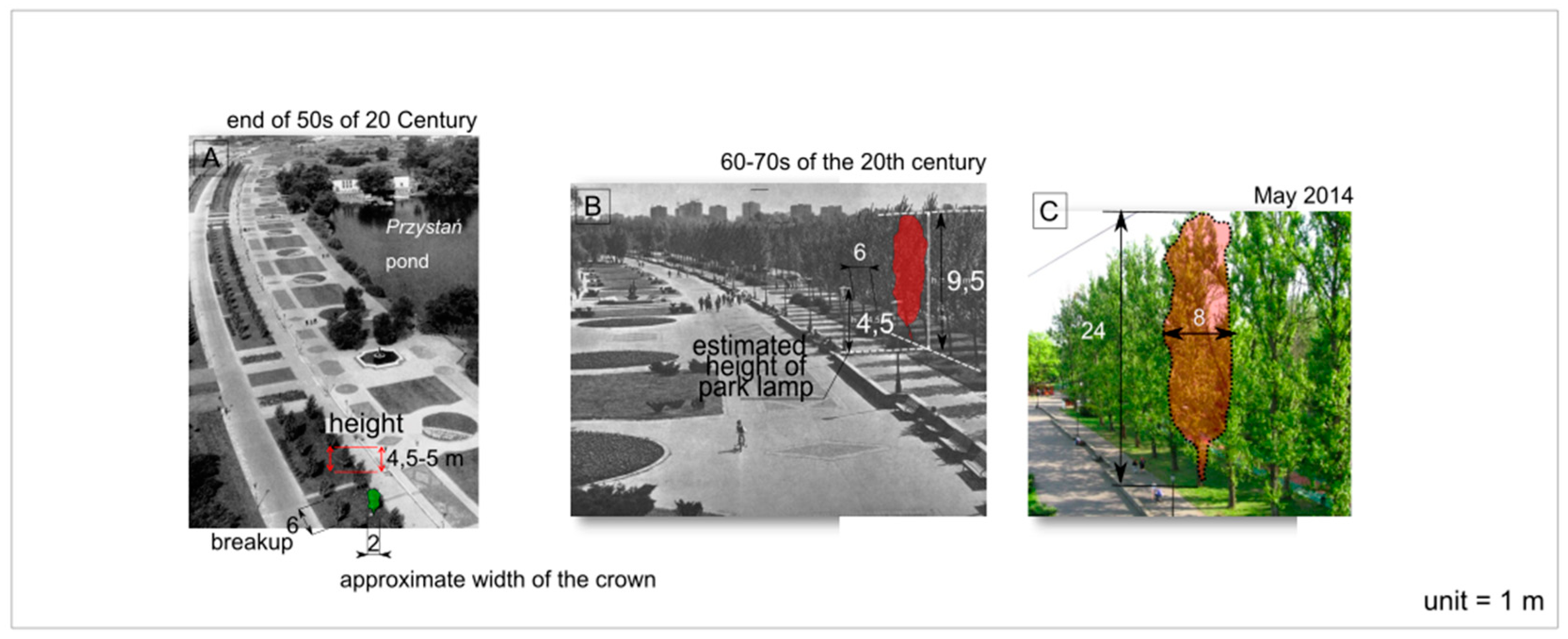
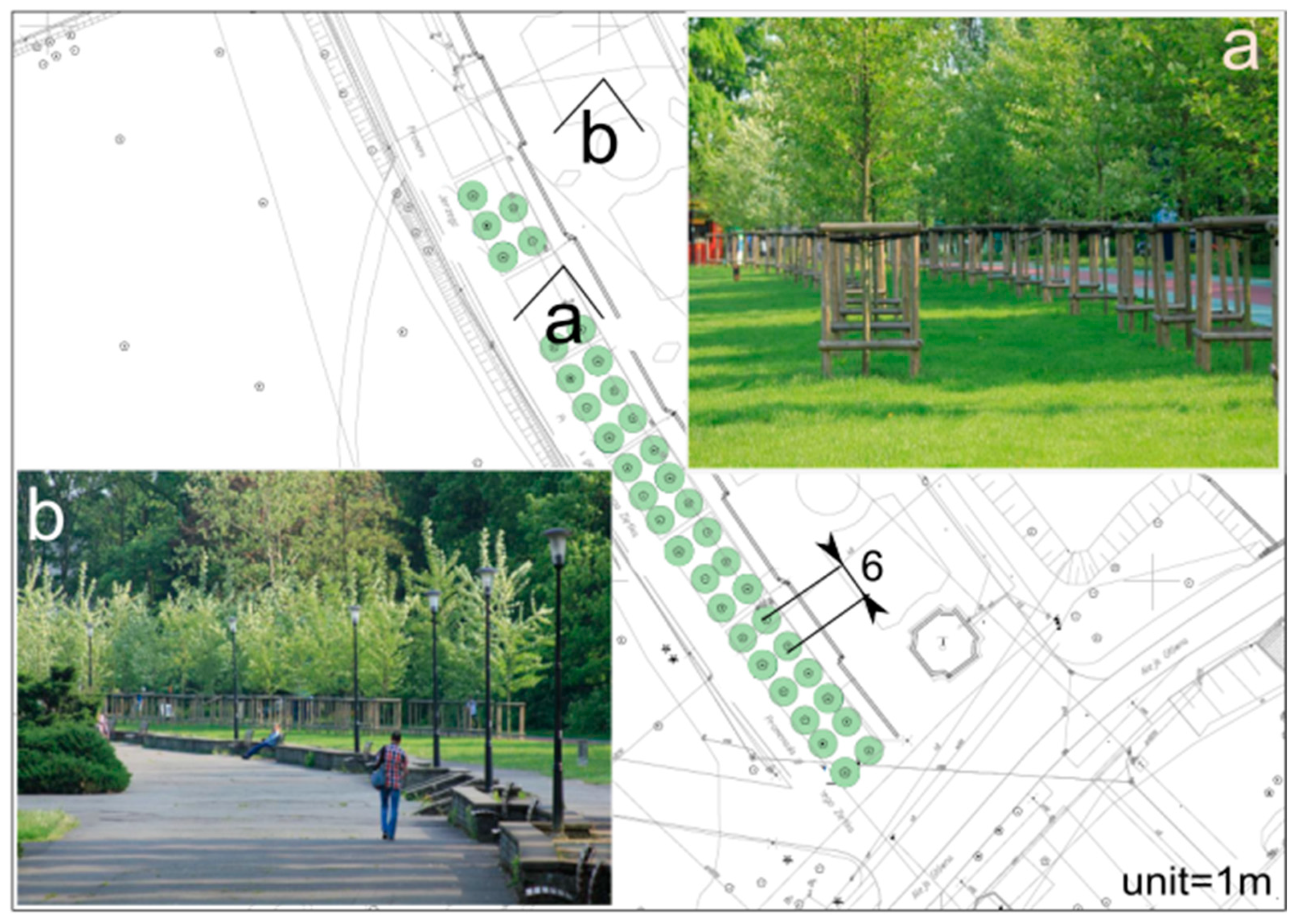
| Balsam poplar section (Tacamahaca) | |
|---|---|
| Subsection | Selected representative |
| American balsam poplars |
P. balsamifera (syn. P. tacamahaca) P. trichocarpa |
| Asian balsam poplars |
P. simonii P. maximowiczii P. laurifolia |
| Intra- and inter-sectional hybrids of balsam poplars |
Europe: P. ×berolinensis (K. Koch)Dippel ‘Berlin’ - Berlin poplar (male form) P. ×berolinensis (K. Koch)Dippel ‘Petrowskyana’ - Berlin poplar - so called “Tsar’s” (female); P. xberolinensis ‘Razumovskyana’ (female form) USA (in 1920s by E.J. Schreiner and A.B. Stout - the so-called Schreinerian hybrids): Populus ‘NE 49’ or ‘Hybrid 194’ (P. x ‘Hybrid 194’) Populus ‘NE 42’ or ‘Hybrid 275’ (P. x ‘Hybrid 275’) Populus ‘NE 44’ or ‘Hybrid 277’ (P. x ‘Hybrid 277’) Populus ‘Androscoggin’, ‘Geneva’, ‘Oxford’ |
| Parameter | Year | Age [years] | Descriptive statistics | t test | ||
|---|---|---|---|---|---|---|
| Mean (+/- SD) | Me | Min-Max | ||||
| height [m] | 2012 [n=16] | 85 | 23.87 (1.86) | 224.00 | 20.0-27.0 | p=0,0175 t=-2.536 |
| 2024 [n=12] | 97 | 25,5 (1.40) | 25.60 | 23.5-27.5 | ||
| circumference [cm] at 1.3 breast height | 2012 [n=16] | 85 | 225.87 (50.98) | 224.00 | 116.00-321.00 | p=0.4341 t=-0.794 |
| 2024 [n=12] | 97 | 241.33 (50.93) | 244.50 | 146.00-339.00 | ||
| Parameter | Year | Age [years] | Descriptive statistics | ||
|---|---|---|---|---|---|
| Mean (+/- SD) | Me | Min-Max | |||
| height [m] | 2016 [n=10] | 3 | 4.96 (0.10) | 5.0 | 4.8-5.1 |
| 2021 [n=10] | 8 | 8.40 (0.51) | 8.5 | 7.6-9.5 | |
| 2023 [n=10] | 10 | 13.90 (0.42) | 14.0 | 13.5-14.5 | |
| circumference [cm] at 1.3 breast height | 2016 [n=10] | 3 | 12.90 (0.87) | 13.0 | 12.0-14.0 |
| 2021 [n=10] | 8 | 63.65 (6.11) | 62.0 | 57.0-76.0 | |
| 2023 [n=10] | 10 | 79.80 (5.12) | 82.0 | 74.0-86.0 | |
| crown average diameter [m] | 2016 [n=10] | 3 | 2.17 (0.26) | 2.0 | 2.0-2.5 |
| 2021 [n=10] | 8 | 4.50 (0.33) | 4.5 | 4.0-5.0 | |
| 2023 [n=10] | 10 | 7.90 (0.26) | 8.0 | 7.5-8.2 | |
| Age | Parameter | growth/1 year | Correlation | ||
|---|---|---|---|---|---|
| R(X.Y) | t | p | |||
| 2-8 | height [m] | 0.69 | 0.9740 | 16.1 | <0.0001 |
| circumference 1.3 [cm] | 10.15 | 0.9831 | 20.1 | <0.0001 | |
| crown diameter [m] | 0.66 | 0.9689 | 14.6 | <0.0001 | |
| 8-10 | height [m] | 0.83 | 0.9853 | 20.8 | <0.0001 |
| circumference 1.3 [cm] | 5.38 | 0.8146 | 5.1 | <0.0002 | |
| crown diameter [m] | 1.33 | 0.9837 | 19.8 | <0.0001 | |
Disclaimer/Publisher’s Note: The statements, opinions and data contained in all publications are solely those of the individual author(s) and contributor(s) and not of MDPI and/or the editor(s). MDPI and/or the editor(s) disclaim responsibility for any injury to people or property resulting from any ideas, methods, instructions or products referred to in the content. |
© 2024 by the authors. Licensee MDPI, Basel, Switzerland. This article is an open access article distributed under the terms and conditions of the Creative Commons Attribution (CC BY) license (http://creativecommons.org/licenses/by/4.0/).





